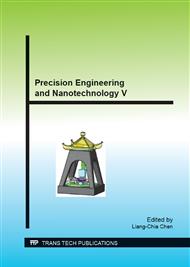p.224
p.230
p.234
p.241
p.247
p.253
p.258
p.262
p.267
Satiny and Continuous-Curvature Corrugated Surface Generation by Integrating End-Milling Processes and Magnetic Polishing with a Machining Center
Abstract:
It is difficult to hand down magic-mirror fabrication technology, which has an extremely small satiny and continuous-curvature corrugated surface, due to downsizing of veteran engineers or even their successors. Therefore, the purpose of this study is to digitalize the magic-mirror fabrication technology using a CNC technology. A mirror finishing method is thus proposed that integrates ball end-milling and magnetic polishing it on the machining center. In addition, the workpiece is end-milled from the rear. Generation of the magic-mirror surface is also carried out.
Info:
Periodical:
Pages:
247-252
Citation:
Online since:
August 2014
Authors:
Price:
Сopyright:
© 2015 Trans Tech Publications Ltd. All Rights Reserved
Share:
Citation:


